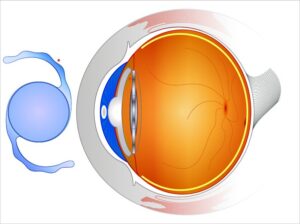Loss Of Near Vision After Cataract Surgery
Cataract surgery is a common procedure that often leads to the loss of near vision. This issue arises because the surgery involves replacing the eye’s natural lens with an artificial intraocular lens (IOL).
The natural lens has the ability to change shape to focus on close objects, a capability that the standard artificial lenses typically lack. As a result, patients will not be able to focus on objects that are close to them, impacting activities like reading or using a smartphone. This significant change in focusing ability can be a drawback for many who undergo cataract surgery, as it alters their vision dynamics, especially for near tasks.
Post-Surgery Near Vision Loss
As mentioned above, one of the common outcomes of cataract surgery is the loss of near vision. This happens because the artificial lens used in the surgery doesn’t accommodate like the natural lens, which adjusts its shape to focus on various distances. Consequently, patients might experience difficulty with tasks like reading or using a phone, a condition often referred to as Farsightedness.

Intraocular Lens Options and Their Impact
The choice of IOL is crucial in determining post-surgery near vision. Monofocal IOLs, the most common type, offer clear distance vision but often require the use of reading glasses after cataract surgery for near tasks. Multifocal IOLs provide clearer vision at multiple distances, including near and far, reducing dependence on glasses. However, they may lead to reduced contrast sensitivity or halos around lights. EDOF IOLs offer an extended range of clear vision, from near to intermediate distances.

How to Improve Near Vision After Cataract Surgery
There are several strategies to improve near vision following cataract surgery. One key approach involves the careful selection of the appropriate type of intraocular lens (IOL) to be implanted during surgery. Advances in IOL technology have led to the development of various lens options, each designed to address specific vision needs. Additionally, post-surgical vision therapy programs can be beneficial. These programs are designed to enhance the brain’s visual processing capabilities, helping patients adapt to their new visual condition. Exercises in vision therapy may include tasks that train the brain as well as the eyes to focus more effectively at different distances, potentially improving the ability to see clearly at close range for patients with multifocal lenses and patients who had mono vision and are straggling with the eye that is focused on near.
For those experiencing loss of near vision after cataract surgery, we recommend:
- RevitalVision Post-Cataract Surgery Program: This home-based training program, consisting of 30 sessions, is designed to improve contrast sensitivity, distance vision and near vision. It has been proven to enhance vision significantly, offering a practical solution for adapting to the new visual capabilities post-surgery.
- Corrective Eyewear: In cases where a monofocal IOL is used, reading glasses or bifocals may be necessary for close-up vision tasks. RevitalVision may be useful for patients that need further near-vision enhancement while using their reading glasses.
- Careful Planning: Discussing presbyopia concerns and available IOL options with an eye care professional before surgery is essential. Understanding the benefits and limitations of each IOL type helps in making an informed decision.
Near Vision After Cataract Surgery
The choice of intraocular lens (IOL) is a critical factor in determining the quality of near vision after cataract surgery. There are different types of IOLs available, each with its own set of advantages and limitations. Monofocal lenses are designed to provide clear vision at one specific distance, typically set for distance vision, which means patients will need reading glasses for near tasks, as they will lose all their near accommodation ability. Multifocal lenses, on the other hand, have multiple focus zones to provide clarity at different distances, including near, intermediate, and far. Extended depth of focus (EDOF) lenses offer a continuous range of vision from near to far, although they may not be as sharp at extreme ranges as multifocal lenses. The selection of an appropriate IOL depends on individual vision requirements and lifestyle needs, making it essential to discuss options with an ophthalmologist.
Difficulty Reading After Cataract Surgery
Reading difficulties are a common complaint among patients who have undergone cataract surgery. This issue primarily stems from the limitations of artificial lenses in accommodating close-up vision, a function that the eye’s natural lens typically performs. As a result, patients may find it challenging to read small print or see details at close range. Addressing this issue may require the use of additional corrective measures, such as reading glasses or bifocals. In some cases, specialized training programs may be recommended to help patients adapt to their new visual condition. These programs focus on techniques and exercises designed to improve the ability to see near objects, enhancing reading and other close-up activities.
In Summary
The loss of near vision after the Surgery is a manageable condition with the right approach and tools. Whether it’s selecting the appropriate IOL, utilizing vision improvement programs like RevitalVision, or using corrective eyewear, options are available to enhance near vision. It’s crucial for patients to have detailed discussions with their eye care professionals about their specific needs and the best strategies for their visual health. Understanding the nuances of each solution helps in addressing the loss of near vision after cataract surgery effectively.
Back to Blog

